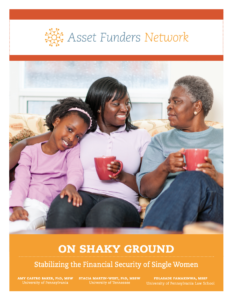 On Shaky Ground: Stabilizing the Financial Security of Single Women
On Shaky Ground: Stabilizing the Financial Security of Single Women
Asset Funders Network
First published November 2018
Women between the ages of 45-65 represent the very first generation to benefit from expanded access to higher education, credit and other asset-building opportunities originating from the civil rights era and women’s movements of the 1960s and 1970s. Today, women are graduating from college in record numbers, starting businesses at unprecedented rates, and have greater access to mortgage and business credit than their mothers and grandmothers. Two-thirds of women are primary breadwinners or co-breadwinners. Many are part of the “sandwich generation” who provide care for one parent or family member over the age of 65 while also raising young children, supporting their grown children, or helping raise their grandchildren.
Yet the 15 million single women within this cohort— particularly Black and Latina women—have lost substantial amounts of wealth in the last two decades. In fact, single women in this cohort, aged 45-65, lost 36% of median wealth between 1995 and 2016, with a 28% drop for White women and a 74% drop for Black women from 2007 to 2016. Additionally, by 2016, the median “quasi-liquid”1 savings for single Black and Latina women aged 45-50 was $0.
The gender wealth gap continues growing even though single women have benefited from regulatory protections to reduce wealth stripping and have had increased access to institutions, products, and services that help them build wealth. This growing gap not only impacts their financial security in retirement but also their ability to pass resources on to future generations.
To shepherd our collective efforts and move the needle to improve the economic well-being of single low-income women, we must understand how asset inequality is compounded by structural barriers to wealth building for women, including accessing income, tax benefits, social services programs, and financial products and services.
Download Resource